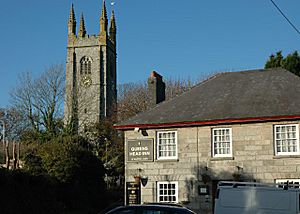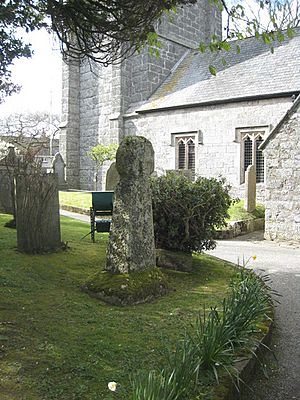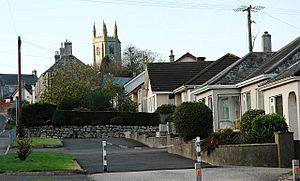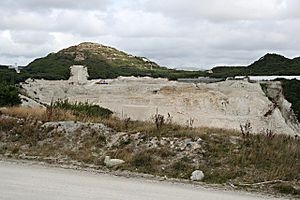St Stephen-in-Brannel facts for kids
Quick facts for kids St Stephen-in-Brannel
|
|
|---|---|
| Lua error in Module:Location_map at line 530: Unable to find the specified location map definition: "Module:Location map/data/Cornwall (mainland)" does not exist. | |
| Population | 7,240 (parish, 2011 Census) |
| Civil parish |
|
| Unitary authority | |
| Ceremonial county | |
| Region | |
| Country | England |
| Sovereign state | United Kingdom |
| Post town | St Austell |
| Postcode district | PL26 |
| Dialling code | 01726 |
| Police | Devon and Cornwall |
| Fire | Cornwall |
| Ambulance | South Western |
| EU Parliament | South West England |
St Stephen-in-Brannel is a village and civil parish in the middle of Cornwall, England. People who live there often call it St Stephen's or just St Stephen. Its Cornish name is Cornish: Eglosstefan yn Branel. The village is about 6.5 kilometers (4 miles) west of St Austell. It sits on the edge of Cornwall's famous china clay area.
The parish includes other villages like Foxhole, Nanpean, Treviscoe, and Whitemoor. It also has smaller areas called hamlets, such as Carpalla, Coombe, Currian Vale, High Street, Hornick, Lanjeth, Stepaside, and Terras. In 2011, about 7,119 people lived in the civil parish.
Inside the parish, at a place called Tolgarrick mill, you can find South Terras Mine. This is one of only two places in the whole United Kingdom where uranium and radium were mined.
Contents
A Look Back: History of St Stephen
In the Middle Ages, the area around St Stephen was part of a royal estate called Brannel. The churches of St Dennis and St Michael Caerhays were connected to St Stephen's church. For a long time, the main priests lived at St Michael Caerhays, so it became known as the "mother church."
The Brannel estate was mentioned in the Domesday Book in 1086. This was a big survey ordered by William the Conqueror to record land ownership in England. The Domesday Book showed that the estate had enough land for 20 ploughs. It also had woodlands, large areas for animals to graze, and many sheep.
The Village Church
The church in St Stephen was officially named after Saint Stephen on August 20, 1261. This was done by Walter Bronescombe, who was the bishop of Exeter at the time.
The church building has a main area called a nave and two side sections called aisles. The font, which is a basin used for baptisms, is very old and dates back to the Norman period. All the stone on the outside of the church is made of granite. The church tower is also built from granite blocks. It holds a set of 8 bells that were remade in 1908. These new bells kept the special messages from the older bells, which were first made in 1730.
The church was repaired and improved between 1893 and 1894 by an architect named George Fellowes Prynne. His brother, Edward Arthur Fellowes Prynne, who was a famous painter, created the beautiful paintings on the church's main altar.
Treneague Cross
In the churchyard, you can see the Treneague Cross. This cross has an old cross head that was found in the late 1800s. It was then placed on a new base and set up in the churchyard. Treneague was once the location of a small chapel that was officially recognized in 1381.
Mining in the Area
Mining has played a huge role in how St Stephen grew and developed. The village became bigger after William Cookworthy discovered large deposits of clay nearby in the 1700s. This clay is known as china clay and is used to make pottery, paper, and many other products.
South Terras Mine
Uranium was mined at South Terras Mine, which is not far from the village. This mining took place between 1870 and 1930. In 1996, the mine area was recognized as a Site of Special Scientific Interest (SSSI). This means it's a special place because of its unique natural features. Scientists have found that a mineral called metazeunerite helps to stop uranium from spreading in the soil at South Terras.
Tregargus Quarries
To the northwest of the church, you'll find Tregargus Quarries. This site is also very important for geology and was named a SSSI in 1951.
Life in St Stephen Village
As St Stephen grew, it started to have many useful services. Over time, it had a police station, a bank, and a bakery.
The village is still growing today, with new homes being built. Sometimes, building new houses on green spaces around the village causes discussions between local people and builders. Residents worry about their privacy and the effect on local wildlife.
Village Facilities
St Stephen has many helpful places for its residents. These include the Brannel Surgery (a doctor's office), St Stephen Churchtown Primary School, and Brannel School (a secondary school). There's also a community center where events are held. The village used to have two pubs, but one, the King's Arms, is now a residential home. You can also find two shops, with one of them also serving as the post office.
In 2012, the postbox outside the post office was painted gold by the Royal Mail. This was a special way to honor local Paralympic swimmer Jonathan Fox, who won a gold medal.
Learning and Schools
St Stephen has two schools for different age groups.
St Stephen Churchtown Primary School
St Stephen Churchtown Primary School opened in 1984. It moved from the center of the village to a new building, which has expanded over the years. The school has more than 250 students in 11 different classes.
Brannel School
Brannel School is the secondary school in St Stephen, and it opened in 1961. It has over 700 students. The school recently moved into a brand new building. This new building can hold up to 750 students. It also has a special area called the Area Resource Base (ARB). This part of the school helps students with special educational or medical needs. It's fully connected to the main school, so students get the support they need while still being part of the wider school community.
In 2000, Brannel School was given "Beacon Status" by the government, which meant it was a leading school. In 2005, it became a specialist college for English and the Performing Arts.
Fun and Recreation
The village's recreation ground opened in 1924. It's a busy place with many clubs and groups, including the village football, cricket, and bowls teams. There's also the Telstar Youth Club. The ground has a football pitch, a cricket pitch, a bowls green, and an all-weather pitch. There's also a sports pavilion that can be used for sports like football and tennis.
Clubs and Groups
St Stephen is home to many different sports teams, societies, and clubs.
Sports Clubs
- A bowls team plays on the bowling green at the recreation ground.
- A cricket team plays its home games at the recreation ground and uses the new pavilion that opened in 2001.
- Two football teams, part of St Stephen FC, play their home games on their pitch at the recreation ground.
- Many other sports clubs use the sports hall and other facilities at Brannel School.
Other Groups
St Stephen also has a Scout group, called 1st St Stephen. They share a meeting place with the 1st Treviscoe–St Stephen Guide group at Trethosa.
The St Stephen Pantomime Company puts on a show every year. These shows are performed in the community center hall and can attract audiences of up to 200 people each night.
Cornish Wrestling
St Stephen has been a center for Cornish wrestling for hundreds of years. The traditional spot for wrestling matches was a special wrestling ring, which is now the car park for the old primary school. Other places used for Cornish wrestling tournaments include:
- The King's Arms field, which hosted tournaments in the 1800s, 1900s, and 2000s.
- The Recreation Ground, which held international wrestling tournaments in 1965 and 1979.
A famous Cornish wrestler named William Pryne (who passed away in 1931) was originally from St Stephen. He became known as "Bill" and went on to become the Cornish wrestling champion of South Africa!
Images for kids
See also
 In Spanish: St Stephen (St Stephen-in-Brannel) para niños
In Spanish: St Stephen (St Stephen-in-Brannel) para niños









